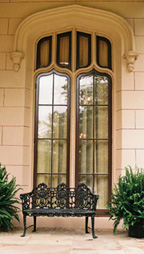 |

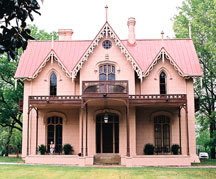 Airliewood is one of the most significant
examples of the Gothic Revival architecture built in the antebellum
south.
Airliewood is one of the most significant
examples of the Gothic Revival architecture built in the antebellum
south.
While many of the grand estates and plantations featured classical Greek Revival style, Airliewood’s steep-pitched roofs, arched doors, windows and details in wooden tracery and cast iron, were prevalent in the Northeast in the 1840s to the 1870s.
Will Henry Coxe and his wife, Amelia, traveled widely. On a 1853 tour of the East they likely saw Gothic estate home designs that were popular in the North.
The Gothic Revival style began in England in 1749 to romanticize medieval styles. Alexander Jackson Davis designed the first American Gothic house in 1832 in Baltimore.
Davis is considered the first American architect to promote Gothic style in his book, “Rural Residences,” the first house plan book published in the United States. Previous publications showed details, parts, pieces and occasional elevations of houses, but Davis’ book was the first to show three-dimensional views of complete floor plans.
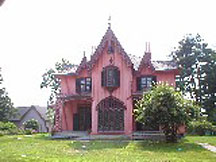 A
friend of Davis, Andrew Jackson Downing, helped popularize the style through
his pattern books and public speaking. Gothic was mostly promoted as
a rural style. The typical scale of Gothic structures didn't
fit city lots.
A
friend of Davis, Andrew Jackson Downing, helped popularize the style through
his pattern books and public speaking. Gothic was mostly promoted as
a rural style. The typical scale of Gothic structures didn't
fit city lots.
Airliewood’s design has been traced to another proponent of Gothic architecture. Samuel Sloan of Philadelphia, was not considered among American architectural “thinkers,” but was one of the first practicing architects.
He began designing buildings at a time when "architect" meant a compiler of imitative patterns for the use of the actual builder, contractor, carpenter or mason.
Very early in his career, the young Sloan wrote a remarkable book, “The Model Architect" (1852-53), a bold call for an essentially American architecture, designed by respected professionals for a public of taste.
“The Model Architect“ went through numerous editions and Sloan’s ideal villas were copied and built across the country.
The book is a compilation of 60 villas, cottages, schools, churches and mansions pictured with lithographs, as well as scaled floor plans and elevations. Each design was accompanied with details of arches, windows, ornaments and joints characteristic of Sloan’s modified Gothic, Grecian, Tudor, Italian, Norman and even Oriental facades.
Specifications, tables and cost estimates give an accurate idea of building conditions in pre-Civil War America.
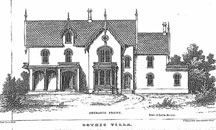 Airliewood
is most closely associated with the illustrations in Sloan’s “Gothic
Villa Design Forty Fifth” in the second edition of his book.
Airliewood
is most closely associated with the illustrations in Sloan’s “Gothic
Villa Design Forty Fifth” in the second edition of his book.
The plan is specific in wall thickness, materials and dimensions. The elevations were drawn to a scale of 13 feet to an inch. The outer walls were to be of quarry stone, and in the cellar were to be a thickness of 20 inches to the first floor. The walls were to be 16 inches thick.
A furnace in the cellar warmed the rooms in the main floor. The nursery over the kitchen would be warmed by a flue from the range below. The division walls were to be of brick and nine inches thick.
The windows were double hung with weights and had inside shutters. Windows under the verandah extend to the floor.
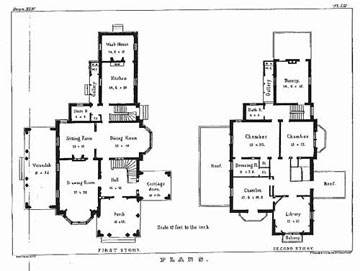 Design
Forty-Five also included floor plans of the first and second stories
drawn to scale. The first story consists of a drawing room, a hall, a
dining room, sitting room, kitchen and wash house in the rear, a large
store room, a carriage drive, porch and verandah.
Design
Forty-Five also included floor plans of the first and second stories
drawn to scale. The first story consists of a drawing room, a hall, a
dining room, sitting room, kitchen and wash house in the rear, a large
store room, a carriage drive, porch and verandah.
The second floor consists of three chambers and dressing rooms, library, nursery, bath room, closets and a water closet approached by a gallery on the outside. The plan accommodated five bedrooms in the attic.
The plan paid great attention to the cellar which extended under the whole of the building. The floor of the cellar was to be coated with a bed of concrete at least six inches thick. Sloan seemed to get on his soap-box when he expounded the importance of the cellar.
"A well ventilated and properly constructed cellar, is an important appendage to any building, and one which neither pain or expense should be spared to secure, even though it be necessary to diminish the expense of another part of the house.
"In too many instances, the custom prevails of making the cellar the depository of vegetable and animal matter. Its decay, especially in the summer time, is ever a prolific source of disease, for its effects must be felt throughout the entire building.
"All such articles of food should be stored in vaults or apartments detached from the main building. The practice of depositing in the cellar refuse matter of any kind, is too manifestly pernicious to need remark here."
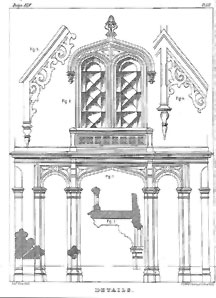 Returning to the subject, Sloan outlines on a page of
patterns for details which illustrate the features of the Gothic Revival
style.
Returning to the subject, Sloan outlines on a page of
patterns for details which illustrate the features of the Gothic Revival
style.
Sloan concludes his narrative about the Gothic Villa with a note to a prospective builder.
"The above description of the principal features, with the aid of one of the general specificatons already given, would enable any one acquainted with the builder's art, to prepare complete specifications fo the erection of this design. Its entire cost in a vicinity where proper stone could be delivered at the rate of ninety cents per perch, and other materials at a proportonate rate, would not exceed nine housand dollars."
Sloan adds a reference to bells and speaking tubes. While noting that bells were formerly found in only the most expensive houses, "lately, they have been introduced in nearly every dwelling constructed with a proper regard to the convenience of the inmates."
Copper wire for the pulls was preferred over annealed iron wire, especially where it might be exposed to moisture. Tin was used for the speaking tubes with mouthpieces made of silver plate, ivory or porcelain.